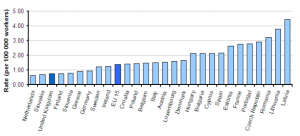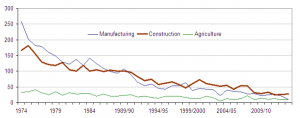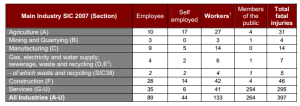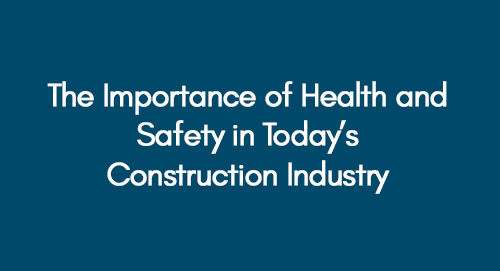
Investigating the Impact of Sustainable Solar Energy Development in the Kingdom of Saudi Arabia
December 30, 2020
The Importance of Procurement Strategy & Impact on Construction Projects
January 13, 2021Executive Summary
The increasing expectations for enhanced health, safety and sustainability parameters have influenced the stakeholders of the construction industry to optimize health and safety measures / strategies. The construction industry in the UK and around the globe has been continuously evolving through research and development, and through application of the state of the art computer aided tools. Much research is also being conducted to enhance the project management practices and mitigation measures; to reduce all forms of risk in the construction project (Teo and Ling, 2006).
In this fast changing industrial environment, it is extremely important to ensure that health and safety concerns in the construction industry are properly addressed through adaptation of integrated strategies. The goal of the industry is to gradually evolve the occupational health and safety in response to continues ecological, social, economical and technological advancement of the modern world. Various form of health and safety regulations as well as codes of practices have been approved by the Health and Safety Executive (HEC), however it is important to investigate whether these regulations are able to enhance the outcome of safety and health or are mere a cost liability on the businesses of the construction industry.
The executive summary of this paper will present the significance of the research completed, while highlighting the scope of works, relevance and the need to specific measures with respect to Health and Safety in Today's Construction Industry.
Furthermore, this section will be outlined to convey the concept of the research completed, the fundamental aspects covered, the method of research adopted and the primary results discovered in a summarized form.
Chapter – 1; Introduction
The social, economical and human resource costs of injuries, accidents and diseases along with any form of industrial disaster has always been considered as a major concern in any industry, nationally and internationally. Various strategies and method have evolved and applied over the years in the construction industry with the aim to eliminate, reduce, control and prevent all forms of risks / hazards; to cope with the economical and technological changes. However, despite of these efforts at the national and international level, there has been slow progress in the overall improvements in the last many years as the reports of the accidents and disasters are still quite frequent. This implies that the cost of the human resource sufferings and the economical burden is still significant in the civil engineering construction industry (Van and Wright, 2005).
Health and safety at sites of construction comprises both physical and psychological wellness of laborers on construction sites and different people whose health is prone to be harmfully influenced by construction site activities. It is of essential importance to employers, workers, governments and project members. In spite of the fact that accident percentages in the construction industry remain unsuitably high, a few accomplishments in health and safety have been achieved. Still, the role of empowering financial, political, social, and institutional environments in the management of health and safety has been under-emphasized.
Individual and organizational competence in Health and Safety (H&S) is a crucial component to the fruitful completion of a construction project in a safe manner and without dangers to the health of the entire workforce. Under the Construction Design and Management (CDM) Regulations 2007, the responsible are ought to make sensible choices to guarantee that the chosen duty-holders and individuals involved are H&S capable to plan, fabricate or co-ordinate the project. Despite the fact that the CDM Regulations 2007 and its Approved Code of Practice (ACoP) have created 'Core Criteria' to guide the customer to evaluate the H&S competence of the duty-holders at the start of a project, it is still hard for most customers with lesser experience to perform the duty of settling on the key choices in H&S competence evaluation.
Keeping in mind the end goal to help the customer execute H&S competence evaluation, it is imperative to develop a tool that can efficiently and effectively help the customer make reasonable choices in the determination of H&S competent duty-holders.
The economical impact of these incidents are considered to be highly significant, as loses in terms of time, production, insurances, compensations etc. costs around 4% of the annual GNP around the globe. Some o the studies also suggest that these numbers show an increase if the major industrial accidents are considered. The social impacts that these incidents can have on the country may not be possible to present in numbers, however, the ethical, moral as well as legal impacts of such incidents cannot be ignored (Benjamin, 2008).
It is important to realize that the industrial as well as occupational fatalities, under most circumstances are caused by factors which are preventable. These factors can be eliminated or at least reduced though undertaking defined measures and methods of safety. Various forms of hazard analyses, mitigation strategies, health and safety procedures and other legal frameworks have been implemented in the UK’s construction industry for the matter. The applications of these methods and measures have considerably reduced the rate of accidents and thus resulted in economical and human befits; as reported by the central heath safety agency HEC of United Kingdom. The World Health Organization (WHO) also reported that the occupational accidents and diseases have declined over the years in the developed countries. However, this is not the case in developing countries where these rates are at level or increasing in some cases.
The research to be completed in this paper is primarily aimed to review the recent extent of health safety concerns in UK’s construction industry, and strategies / investigate the impact of the current systems in terms of expectation, outcomes and prospective developments / enhancements in the near future.
Research aims
The aims of this research are;
- Develop understanding of why Health and Safety is important.
- Investigate the concerns of safety and health with respect to the construction industry of UK.
- Analyze the different legal, methodological and strategic frameworks of health safety.
- Further analyze their impact in light of the current standing / situation of the construction industry.
- Through research, indentify different methods/strategies that can improve the health and safety and the principles in occupational safety and health.
- Indentify the key roles / responsibilities of stakeholders of the industry with respect to health and safety.
- Analyze the effectiveness of different strategies; such as maintaining risk register, mitigation strategy, hazard analyses etc.
Research Objectives
The research objectives are;
- To analyze the trend of fatalities in the industrial sector with the UK. Discuss the results and highlight the changes in the last few years
- Explore health and safety related national policies, and compare the trends in terms of their impact on health and safety
- Critically analyze the role of governmental bodies in drafting as well as implementing these policies
- Outline the results in terms of cost and reduction in casualties
- Undertake analyse of the data obtained through research and present arguments on whether the implementation of these policies have produced fruitful results; both in terms of cost and human resource impacts
- Suggest if the governing systems in place in the UK are producing the expected results, and are there any room for further improvements
- Undertake detailed investigations on the strategies and methods in place for optimum health safety in the construction. Demonstrate the procedures with examples or case studies, while indentifying the responsibilities of the all the stakeholders involved in a particular construction project. This may also indentify the best practices that must be followed to ensure high standard of health and safety for a particular project
Conclusion: This research is being undertaken to assist in building an understanding of why health and safety is still relevant in the construction industry today. This is pertinent to the profession as this may help to reduce the mortality rates and justify the costs of implementing health and safety within the construction environment (as many view this as an unnecessary practice which is time consuming and expensive (Choudhry and Fang, 2008), whereas in fact it may save costs and lives (Chan, Chan and Choi, 2010).
Chapter – 2; Literature review
Workplace Health and Safety (H&S) is a worldwide concern for sustainable development of our generation and civilization. As per the International Labor Office (ILO), work-related illnesses and accidents contribute 3.9 percent of all deaths and 15 percent of the population of the world endures a minor or major work related accident or disease in any one year (ILO, 2005). Other than the physical as well as ethical concerns, the financial expense is significant. The work-related incidents cost the United States US$125.1 billion in 1998 (1.5% of GDP – National Safety Council, 1999) and Britain in the middle of £14.5 and £18 billion every year (2.1% - 2.6% of GDP – Health and Safety Executive, 1999) (Smallman, 2001).
While analyzing and comparing different occupations and industries, it can be observed that construction work is inherently more hazardous as it is still, to a great extent, labor-intensive. The construction industry contributed around 60,000 fatalities out of a global aggregate of 355,000, about 17 percent (ILO, 2005). As a major employment source, the potential rate of serious accidents on and around sites of construction is high. The fundamental reasons of these fatalities outlined by Kartam, 1997 and Fewings, 2005, which are as below;
- Environmental factor: Many individuals from diverse groups, for example, customers, designers, engineers, suppliers, builders and others are typically working near one another on an outside site packed by different construction material and plants.
- Physical factors: Many unplanned activities are unpredictable with respect to design and construction.
- Behavioral Factor: The resistance towards risk is generally high.
Moreover, the structural and social attributes of construction are not in the favor of H&S improvement in the construction industry. This results in more than 60,000 yearly lethal accidents on construction sites globally – or one deadly accident every ten minutes. The following are the fundamental findings of this report (ILO, 2005);
- One in six lethal accidents at work happens at a construction site.
- In industrialized nations, 25-40 percent of work-related deaths occur on construction sites, despite the fact that the part utilizes just 6-10 percent of the workforce.
- In a few countries, it is evaluated that 30 percent of construction laborers experience the ill effects of back pains or other musculoskeletal issues.
Generally, the UK has one of the best records for H&S execution worldwide and the British construction industry is one of the most secure in Europe. Investigating this statement, the following data has been obtained from the Eurostat, European Commission.

Figure 1; Standardized fatality rates across Europe (source: Eurostat, 2014)
The figure above presents the standardized accident rates for every hundred thousand workers at work, in different European countries for the year 2011. This data proves the fact the United Kingdom is amongst the lowest contributor to the fatal injuries across the major European countries.
However, in the year 2005/2006, the rate of fatal injuries to the construction workers was 3.0 deaths every hundred thousand workers while the overall industry average was 0.71. Notwithstanding the fatal injury rate is proceeding with the descending pattern of recent years, construction is still a division connected with a disproportionately high number of employment related diseases and accidents. To enhance the H&S performance in the UK construction industry, legislative and organizational endeavors have been made by the government and industry to create a methodical legal framework and preventive systems. The following section provides review of the history of Health and Safety Regulations in the UK.
Note: investigating the detailed of each of the regulations is not in the scope of this research; therefore only introductions of the most influential regulations have been covered in this research.
Background of Health and Safety Regulations
There are various regulations related to health and safety in the construction industry, and almost all regulations have been derived from enabling act “HSWA” of parliament in 1974. Under the umbrella of this act and as a member of the European Union (EU), UK also adopted the EU legislations as a part its regulations. In an effort to enhance the health and Safety of workers, a specified framework of procedures in the form Management of Health and Safety at Work Regulations (MHSW) was adopted by UK in 1992, which was then revised in the year 1999. This framework provided specific guidelines and expectation under the fundamental HSWA 1974, detailing key parameters such as process of the risk assessments and other key safety measures such as surveillance, planning, training, and management of health and safety. Specific regulations are consequently applied to range construction activities in light of these frameworks.
In continuation of these frameworks, the two specific H&S regulations were developed in the UK for the construction industry, which are;
- CHSW (Construction Health, Safety and Welfare) 1996 regulations. These regulations were developed to address almost all the health and safety concerns, covering most of the construction related activities, apart from working at height. Another specific regulations were developed in 1998 and revised in 2003 to cover the scope of working at height and lifting operations, names as Work at Height Regulations 2003
- The Construction Design and Management regulations were initially developed in 1994, which were than revised to develop CDM Regulations 2007, after incorporating the CHSW regulations of 1996. The CDM Regulations 2007 has been considered as the bible of construction works by the stakeholders of this industry, as it has been aimed to enhance the performance of the project from the very initial stages of the projects.
The CDM regulations provide specific support in the following;
- Hazard indentification during the early stages of the project. The regulations requires the construction practitioners / responsible to undertake extensive hazard analyses process to indentify all form of hazard associated with the projects, assign responsibilities and take early mitigations to ensure that the control measures are taken to eliminate the risks.
- The regulations encourage the stakeholder to provide sufficient resources to enhance the health and safety
- Discourage unnecessary activities, to avoid and form of distraction
In order to provide guidelines of regulation compliance to the industry, HSE has developed the Approved Code of Practice (ACoP) for most of regulation sets, which provides necessary details on how to comply by the regulations. These sets of guidelines have been categorized into 2 sections, which are ‘best practices’ and ‘legal’. The legal section of the ACoP covers the technical aspects H*S regulations, where as best practices guidance booklet provides details on the best operating procedures; implications of which can ensure that the practitioners are complying with the existing legal regulations (Hughes and Ferrett, 2011).
The H&S compliance of regulations are assessed with the requirements of the projects, and are then compared with the proof given by the candidate duty-holders with the benchmark standards, and then decisions are taken according to his individual experience, knowledge and guidelines (Carpenter, 2006a). For members with very little construction knowledge (Egbu and Robinson, 2005), it could be hard to manage such an information and intensive works, even with the help of 'Core Criteria'. However, with the advancement of information technologies (I.T.), a lot of PC based systems have been connected to manage numerous construction issues (Heesom, 2004).
H&S Impact Assessment of Regulations
Work-related ill-health in construction generally influences the health of workers. Handling and utilizing tools, materials and substances can bring about breaks, strains, musculoskeletal issues (MSDs), hearing loss, cement burns, dermatitis, hand arm vibration syndrome and ensuing long term disability. All such forms of health and safety converns in the construction industry are important as according to the Health and Safety Executive (HSE) in the United Kingdom (UK) though ‘… there have been significant reductions in the number and rate of injury over the last 20 years or more. Nevertheless, construction remains a high risk industry (HSE, 2014).
Although HSE has experienced a decline in incidents, as reported by the Reporting of Injuries, Diseases, and Dangerous Occurrences Regulations 2013, the Health and Safety still remains a matter of concern for the industry (HMSO, 2013; HSE, 2014). According to recent statistics;
“42 fatal injuries to workers were reported. 14 of these fatalities were to the self-employed. This compares with an average of 53 over the previous five years - including an average of 18 to the self-employed (RIDDOR)… an estimated 1.4 million working days were lost in 2011/12, 818 thousand due to ill health and 584 thousand due to workplace injury, making a total of 0.7 days lost per worker (LFS, 2012)’ (HSE, 2014: online)”.
This demonstrates that there are still a high number of deaths in the construction industry each year, which makes the risks associated with this higher than other industries (Hartley and Cheyne, 2012: 178-180; HSE, 2013: 4). This is also reiterated in the academic literature, Hale, Walker, Walters and Bolt (2012) found that there are ‘a concentration of underlying factors associated with inadequacies in planning and risk assessment, competence assurance, hardware design, purchase and installation, and contracting strategy’ (Hale, Walker and Bolt, 2012) which led to the deaths of workers between 2006 to 2008. From this, we may determine that even though the mortality rates of workers in the construction industry are declining, deaths still occur due to poor implementation of health and safety practices in this context. Therefore, from this perspective we can understand why health and safety is still important in the construction industry today, as some of these accidents or incidents may not have occurred if this was appropriately implemented in practice.
H&S competence refers to the degree of learning, ability and experience that empower a group or an individual to do certain work with safety (Hughes and Ferrett, 2005; Carpenter, 2006a; Carpenter, 2006b). It has been generally recognized that H&S competence is a critical marker in the improvement of a positive health and safety culture (Taylor, 2002; Mohamed, 2002; Hughes and Ferrett, 2005; Lingard and Rowlinson, 2005).
Qualified and experienced responsible(s) and team who understand their lawful commitments in accordance with the applicable regulations, and additionally the standards and practices of health and safety administration can effectively minimize the likelihood of accidents in the construction process and amplify the project value. Most H&S specific construction enactment has competence implications or necessities for relative experts (Carpenter, 2006a).
Chapter – 3; Methodology
Since the construction industry is perceived as a stand out amongst the most risky industries, H&S issues are widely considered “as high priority area” in this industry as well by the relevant governing bodies, and there have been various attempts to reduce the frequency of accident and occupational illness (Lingard and Rowlinson, 2005). Mishaps that happened in a project would not just result in human tragedies, de-motivation the workforce, disturb activities on the site and delay the project progress, but also adversely affect the overall expense, reputation and productivity of the construction industry (Mohamed, 1999). With a specific goal to “advance the health and safety performance in the business”, various programs including computer aided tools are now considered as a creative component for driving non-stop improvement (Lingard and Rowlinson, 2005).
Completion of any human activity, under most cases, is not possible without knowledge. As far as a realistic perspective, learning is a combination of experience, values, logical data, and expert knowledge, and can be seen as the most influential driving force of production (Marshall, 1972; Davenport and Prusak, 1998). In the present day world, learning is an irreplaceable premise for settling on a choice. A choice is a bit of information prompting a decision between alternatives; and choice making is, along these lines, a knowledge-intensive activity which produces knowledge about what to do (Holsapple and Whinston, 1996).
Therefore, the methodology of this research is based upon gathering the Health and safety information, investigating the trends of incidents that incurred in the last few years in the UK and comparing these results with records of previous years. The results will then be analyzed to enable the research to propose further methods that can be adopted to enhance the Health Safety concerns in the UK.
According Reporting of Injuries, Diseases and Dangerous Occurrences Regulations 2013 (RDDOR), it is the responsibility of the employers, self employees, and the personnel involved in work premises to report any accidents, injuries, and form occupational diseases. It is also important to segregate the different industries from Civil Engineering Construction Industry, especially when analyzing the details of fatal injuries to employees. Under the Standard Industrial Classification (SIC, 2007), the construction works lies under the section 41 to 43, which includes development of new buildings and infrastructure, ports bridges, road etc. This also includes all form of demolition works, repairs remodeling and maintenance of such infrastructures.
In order to compare the health and safety incidents across major industries of the UK, the following data was obtained from various sources, including Health and Safety Statistics, for the year 2013/14. The figure below presents fatal injuries incurred in the manufacturing and agriculture industries, in comparison with the construction industry from the year 1974 to 2013/14

Figure 2; Industrial fatality comparison in UK (source: RIDDOR, 2013)

Figure 2; Industrial comparison of fatal injuries, averaged from 2008to 2013 (source: The Office for National Statistics (ONS))
The results show that although there has been substantial reduction of fatal injuries in the last four decades, the construction industry remains a significant contributor to the number of fatal injuries, as already discussed in the literature review. These recent results show that this trend has not changed as by the year 2013/14.
In the year 2013/14, a total of 42 fatal injuries were reported to RDDOR, out of which 14 were sustained by the self employees. Comparing this data with the fatal injuries recorded in the last 5 years, there has been reduction of 4 numbers of injuries; as the average of fatal injuries have been 46 in the last 5 years, as shown in the figure below;

Figure 4; Yearly caparison of fatal injuries in UK’s construction industry (source: RIDDOR, 2013)
It is also important to note that construction industry in the UK accounts for only 5% of total employees in Britain, however the construction industry accounts for 32% fatal injuries, and 10% of other specific injuries, which is in fact the largest number of fatalities in the UK’s industrial sections. In order to analyze the methods that can be adopted to improve the health and safety concerns, it is important to further investigate the fundamental causes of these incidents.
According the HSE’s report of 2014 on health and safety statistics, 45 % of the fatal injuries incurred due to fall from height of the construction workers. Machinery contact, electrical contacts, hits by vehicle and struck by other objects contributed to 7% casualties each. Other causes such as slips, tapping, collapsing and struck against contributed to a total of 6%.
Similarly, major/specified injury cases accumulated to a total of 1900 in the year 2013, which is approximately 500 numbers of fewer injuries as compared to the previous 5 years average. However the important aspect determined while reviewing the data has been that; here again, the major contributor of specific injuries has been the fall from height, which was 31% for the year 2013. Trips, falls and slips from the same lever accounted for 27%, whereas struck by object and injuries related to handling and lifting contributed to a total of 22%.
This is a really important form of data, which has been collected through the RIDDOR reporting system, as it shows the distribution of the injuries sustained by the construction workers. The data can provide platform through which revised form of standard operating procedures can be adopted to ensure that high emergency areas where most of the fatalities incur are addressed on priority. This can potentially result in substantial decrease in health safety issues in the construction industry. This issue has been further discussed in next chapter.
However, fatal injuries / accidents are not the only concern of health and safety in the construction industry, as various other forms of issues such as ill health, work related diseases and over 7-day injuries are also considered of prime importance in maintain health and safety in the construction industry. The data of the overall heath associated risk in various occupation and industries Labour Force Survey (LFS), which estimated that from the year 2010 to 2013, around 7000 workers of the construction industry suffered from ill health issues. These numbers are marginally higher as compared to the data of the all industries (THOR-GP, 2014). Similarly, the statistics of the over 7 day injuries to employees of construction industry revealed that there were 3293 total number of injuries, which shown significant reduction in the average injury rates as compared to the records of the last 5 years.
Conclusion: H&S data analyses revealed that although overall health and safety has much improved in the last few decades, there have been only slight improvements in major/specific injuries from the last 5 years. The slow improvements rates may suggest that although the implication of UK’s H&S related regulations have been extremely successful, it may have reached a level where new innovative techniques may required to further enhance the health and safety of the construction industry. These details will be discussed in the next chapter
Chapter – 4; Findings (Results and Discussion)
This chapter will present the analyses of the data collected/presented in the literature review and methodology sections of the paper. The focus of the research will be to investigate the data in order to outline the visible trends and suggest the need of further improvements in the current system. The key findings will be discussed with examples in this section.
Effort will be made to ensure that the completed sections completed in this paper are coherent. A clear connection will be established in-between all the sections to ensure continuity of the paper.
Chapter – 5; Conclusions
Conclusive arguments, fundamental learning and influential factors that can play a pivotal role in defining the health and safety of the construction industry of UK will be presented under this section. The fundamental roles and responsibilities of the stakeholders and the governing bodies will also be outline under this section.
Furthermore, any opportunity of future research (if) indentified through research will also be included under this section.
References
- Benjamin, O. ALLI., (2008). Fundamental principles of occupational health and safety, second edition, International Labour Organization.
- Best, R., (2002). Design & Construction – Building IN Value., Oxford, Taylor & Francis Chan, D. W., Chan, A. P., & Choi, T. N. (2010). An empirical survey of the benefits of implementing pay for safety scheme (PFSS) in the Hong Kong construction industry. Journal of safety research, 41(5), 433-443.
- Choudhry, R. M., & Fang, D. (2008). Why operatives engage in unsafe work behavior: Investigating factors on construction sites. Safety science, 46(4), 566-584.
- Creswell, J. W. (2012). Qualitative inquiry and research design: Choosing among five approaches. London. Sage.
- Eurostat, (2014). Standardised incidence rates (per 100 000 workers) of fatal accidents at work for 2011. Available online from: http://ec.europa.eu/eurostat/publications/
- Government Construction Strategy, 2011. A One Year on Report an Action Plan Update. Cabinet Office, Government Construction Strategy. Cabinet Office, 2011
- Hale, A., Walker, D., Walters, N., & Bolt, H. (2012). Developing the understanding of underlying causes of construction fatal accidents. Safety science, 50(10), 2020-2027.
- Hartley, R., & Cheyne, A. (2012, April). Safety culture in the construction industry. In Contemporary Ergonomics and Human Factors 2012: Proceedings of the international conference on Ergonomics & Human Factors 2012, Blackpool, UK, 16-19 April 2012 (p. 295). CRC Press.
- HMSO (2013) The Reporting of Injuries, Diseases, and Dangerous Occurrences Regulations 2013. Available from http://www.legislation.gov.uk/uksi/2013/1471/contents/made (Accessed 24/03/2014)
- Holroyd T, (2003). Buildability: Successful construction from Concept to Completion. M, London, Thomas Telford Pub. John Wiley & Sons Ltd.
- HSE (2014) Construction Industry. Available from http://www.hse.gov.uk/STATISTICS/industry/construction/index.htm (Accessed 24/03/2014)
- HSE (2013) Health and safety in construction in Great Britain, 2013. Available from http://www.hse.gov.uk/STATISTICS/industry/construction/construction.pdf (Accessed 24/03/2014)
- Hughes, P., & Ferrett, E. (2011). Introduction to Health and Safety in Construction: The Handbook for Construction Professionals and Students on NEBOSH and Other Construction Courses. Routledge.
- RIDDOR, (2013). Reporting of Injuries, Diseases and Dangerous Occurrences Regulations. Available online from: http://www.hse.gov.uk/riddor/
- Standard Industrial Classification – SIC, (2007). UK Standard Industrial Classification of Economic Activities 2007. Available online from http://www.ons.gov.uk/ons/guide-method/classifications/current-standard-classifications/standard-industrial-classification/index.html
- Teo, E.A.,L. and Ling, F.Y.Y (2006) Developing a model to measure the effectiveness of safety management systems of construction sites, Building and Environment 41,pp. 1584–1592.
- THOR-GP, (2014). The Health and Occupation Research Network in General Practice. Available online from: http://www.population-health.manchester.ac.uk/epidemiology/COEH/research/thorgp/
- Van der Schaaf, T.W. and Wright, L.B. (2005) Systems for near miss reporting and analysis. In J.R. Wilson & E.N. Corlett (Eds.), Evaluation of Human Work.
Free Dissertation Topic




























